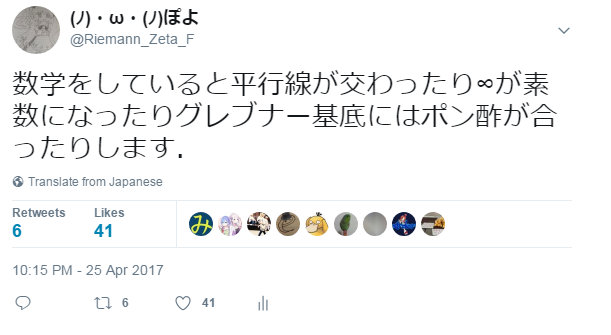玉河数と Riemann zeta関数
2017.07.01.
@ロマンティック数学ナイト

@Riemann_Zeta_F
\displaystyle
\zeta (s) =
\sum_{k = 1}^{\infty}
\frac{1}{k^s}
ζ(s)=k=1∑∞ks1
\displaystyle
\mathrm{Tam} (\mathbb{G}) =
\prod_{p: \mathrm{prime}}
\frac{|\mathbb{G}(\mathbb{F}_{p})|}{p^{\mathrm{dim} \mathbb{G}}}
Tam(G)=p:prime∏pdimG∣G(Fp)∣
\displaystyle
\tau (\mathbb{G}) =
\int_{\mathbb{G} (\mathbb{Q})\backslash\mathbb{G}(\mathbb{A})}
\omega_{\mathbb{A}}
τ(G)=∫G(Q)\G(A)ωA
\displaystyle
\lim_{t \to \infty}
\frac{\mathrm{Tam}_{t} (\mathrm{E})}{(\mathrm{log}~t)^{r}}
t→∞lim(log t)rTamt(E)
\displaystyle
\displaystyle
\zeta_{\mathbb{G}/\mathbb{F}_{1}} (s) =
\lim_{p \to 1}
\zeta_{\mathbb{G}/{\mathbb{F}_p}} (s)
ζG/F1(s)=p→1limζG/Fp(s)
\displaystyle
\mathrm{ord}_{s = 1}
L(s, E/\mathbb{Q}) =
\mathrm{rank} E(\mathbb{Q})
ords=1L(s,E/Q)=rankE(Q)
\displaystyle
\rho : \mathrm{Gal} ( \overline{\mathbb{Q}} / \mathbb{Q}) \longrightarrow GL_{n} (K)
ρ:Gal(Q/Q)⟶GLn(K)

自己紹介.
・
\displaystyle
14
14
歳,中学
\displaystyle
2
2
年生.
・昨年の
\displaystyle
7
7
月にある
\displaystyle
2
2
人の日曜数学者のブログを
見て,数学に興味を持つ.
・好きな四字熟語は虚数乗法,好きな素数は
と
\displaystyle
37
37
\displaystyle
691
691
と
\displaystyle
1229
1229
\displaystyle
7758337633
7758337633
と
他多数.
・グレブナー基底にはポン酢派.


素数は無数に存在する.
\displaystyle
\mathrm{Theorem. ~~~ (Euclid, 3 B.C.)}
Theorem. (Euclid,3B.C.)
\displaystyle

Adele
\displaystyle

Adele
素数を定義通りに列挙する:
\displaystyle
2, 3, 5, 7, 11, 13, 17, 23, 29, 31, 37, \cdots
2,3,5,7,11,13,17,23,29,31,37,⋯
というように無限に続く.

\displaystyle

Adele
ここで記号
\displaystyle
\infty
∞
を導入すれば,素数は
\displaystyle
2, 3, 5, 7, 11, 13, 17, 23, 29, 31, \cdots , \infty
2,3,5,7,11,13,17,23,29,31,⋯,∞
とストップする.
\displaystyle
\infty
∞
を無限素点とよび,通常の
\displaystyle
p
p
を有限素点とよぶ.
素点を表す文字として
\displaystyle
\nu
ν
を用いる.
\displaystyle
\hat{}
^
\displaystyle
\mathbb{P}
P
\displaystyle
= \mathbb{P}
=P
\displaystyle
\cup
∪
\displaystyle
\infty
∞
素点全体の集合を
\displaystyle
\hat{}
^
\displaystyle
\mathbb{P}
P
とすると,
と書ける.
\displaystyle

Adele
有理数体
\displaystyle
\mathbb{Q}
Q
の局所化として各素点
\displaystyle
\nu \in
ν∈
\displaystyle
\mathbb{P}
P
\displaystyle
\hat{}
^
に対して局所体
\displaystyle
\mathbb{Q}_{\nu}
Qν
が,
\displaystyle
\mathbb{Q}
Q
の絶対値
\displaystyle
{\left|~~\right|}_{\nu}
∣ ∣ν
\displaystyle
\nu = \infty
ν=∞
の定める距離の完備化として得ら
れるわけである.
i.e.
のときは
\displaystyle
{\left| a \right|}_{\infty} ~~~~
{\left | a \right|}.
∣a∣∞ ∣a∣.
\displaystyle
\mathrm{def}
def
\displaystyle
=
=
\displaystyle
\nu = p
ν=p
のときは
\displaystyle
{\left| a \right|}_{p} ~~~~
p^{-\mathrm{ord}_{p} (a)}.
∣a∣p p−ordp(a).
\displaystyle
\mathrm{def}
def
\displaystyle
=
=
\displaystyle
{\left| 0 \right|}_{p} ~~~~
0,
∣0∣p 0,
\displaystyle
\mathrm{def}
def
\displaystyle
=
=
\displaystyle

Adele
\displaystyle
\mathrm{Theorem.}
Theorem.
\displaystyle
{\left| a \right|}_{\nu} =
0
\Longleftrightarrow
a = 0
∣a∣ν=0⟺a=0
\displaystyle
{\left| ab \right|}_{\nu} =
{\left| a \right|}_{\nu}
{\left| b \right|}_{\nu}
∣ab∣ν=∣a∣ν∣b∣ν
\displaystyle
{\left| a + b \right|}_{\nu} \leqq
{\left| a \right|}_{\nu} +
{\left| b \right|}_{\nu}
∣a+b∣ν≦∣a∣ν+∣b∣ν
\displaystyle
\mathrm{Theorem.}
~~~~
(\mathrm{Strong ~ Triangle ~ Inequality})
Theorem. (Strong Triangle Inequality)
\displaystyle
{\left| a + b \right|}_{p} \leqq
\mathrm{max} ({\left| a \right|}_{p}, ~ {\left| b \right|}_{p})
∣a+b∣p≦max(∣a∣p, ∣b∣p)
\displaystyle

Adele
\displaystyle
\mathbb{Q}
Q
の
そこで,
点
\displaystyle
2
2
\displaystyle
a, b
a,b
の距離
\displaystyle
d_{\nu} (a, b)
dν(a,b)
を
\displaystyle
d_{\nu} (a, b) =
{\left| a - b \right|}_{\nu}
dν(a,b)=∣a−b∣ν
と定めると
\displaystyle
\mathbb{Q}
Q
は距離空間となり,
\displaystyle
d_{\nu}
dν
による
の完備化と
\displaystyle
\mathbb{Q}
Q
して完備な距離空間
を得る.
\displaystyle
\mathbb{Q}_{\nu}
Qν
\displaystyle
\mathbb{Q}_{\nu}
Qν
は体となり,
\displaystyle
a = \nu - \lim_{n \to \infty} a_{n}
~~~~~
(a_{n} \in \mathbb{Q})
a=ν−n→∞liman (an∈Q)
のとき
\displaystyle
{\left| a \right|}_{\nu} =
\lim_{n \to \infty}
{\left| a_{n} \right|}_{\nu}
∣a∣ν=n→∞lim∣an∣ν
により
\displaystyle
\mathbb{Q}_{\nu}
Qν
に絶対値
\displaystyle
{\left| ~~ \right|}_{\nu}
∣ ∣ν
が拡張される.
\displaystyle

Adele
\displaystyle
\mathbb{Q}_{\nu}
Qν
このようにして,各
\displaystyle
\nu \in
ν∈
\displaystyle
\hat{}
^
\displaystyle
\mathbb{P}
P
に対し局所体
が得られた.
\displaystyle
\nu = \infty
ν=∞
のとき
\displaystyle
\mathbb{Q}_{\nu} =
\mathbb{R}.
Qν=R.
\displaystyle
\nu = p
ν=p
のとき
\displaystyle
\mathbb{Q}_{p}
\cdots
p
Qp⋯p
- 進数体
\displaystyle
.
.
\displaystyle
\mathbb{Q}_{p}
Qp
の部分集合
\displaystyle
\mathbb{Z}_{p} =
\{a \in \mathbb{Q}_{p} ~ \mid ~ {\left| a \right|}_{p} \leqq 1\}
Zp={a∈Qp ∣ ∣a∣p≦1}
は
の部分環
\displaystyle
\mathbb{Q}_{p}
Qp
(
\displaystyle
\mathbb{Q}_{p}
Qp
の加法について閉じている
)
.
\displaystyle

Adele
直積
\displaystyle
\prod_{\nu \in \hat{\mathbb{P}} }
\mathbb{Q}_\nu
ν∈P^∏Qν
の要素
\displaystyle
a = (a_\nu)
a=(aν)
に対して,
\displaystyle
a = (a_{\nu})
a=(aν)
\displaystyle
\Longleftrightarrow
⟺
\displaystyle
\mathrm{def}
def
有限個の
\displaystyle
p
p
を除いて
\displaystyle
a_{p} \in \mathbb{Z}_{p}
ap∈Zp
がAdele
とし,Adeleの全体を
\displaystyle
\mathbb{A}
A
と書く.
有理数体
\displaystyle
\mathbb{Q}
Q
は対角写像
\displaystyle
a \longmapsto
(a, ~ a, ~ \cdots, ~a, \cdots), ~ a \in \mathbb{Q}
a⟼(a, a, ⋯, a,⋯), a∈Q
により
\displaystyle
\mathbb{A}
A
の中の離散的な部分加群とみなされる.
商群
\displaystyle
\mathbb{A} \backslash \mathbb{Q}
A\Q
は
Compact.
\displaystyle
\mathrm{Definition.}
Definition.
\displaystyle

Adele
\displaystyle
\mathbb{A}
A
\displaystyle
\mathbb{Q}_{2}
~~~
\mathbb{Q}_{3}
~~~
\mathbb{Q}_{5}
~~~
\mathbb{Q}_{7}
~~~
\mathbb{Q}_{11}
~
\cdots
\cdots
~
\mathbb{Q}_{\infty}
Q2 Q3 Q5 Q7 Q11 ⋯⋯ Q∞
\displaystyle
\mathbb{Q}
Q
\displaystyle
\mathbb{Z}
Z
Adele ring
Local field
Rational field
Rational integer ring
\displaystyle

Riemann zeta関数
\displaystyle

Riemann zeta関数
\displaystyle
\zeta (s)
ζ(s)
\displaystyle
=
=
\displaystyle
\mathrm{def}
def
\displaystyle
\sum_{k = 1}^{\infty} \frac{1}{k^s}
k=1∑∞ks1
\displaystyle
\mathrm{Re} (s) > 1.
Re(s)>1.
\displaystyle
\mathrm{Definition.}
Definition.
\displaystyle
\mathrm{Theorem.}
~~~
(\mathrm{Basel ~ problem)}
Theorem. (Basel problem)
\displaystyle
\zeta (2) = \frac{\pi^{2}}{6}.
ζ(2)=6π2.
\displaystyle

Riemann zeta関数
\displaystyle
\zeta (s) = \prod_{p \mathrm{: prime}} \frac{1}{1 - \frac{1}{p^s}}.
ζ(s)=p:prime∏1−ps11.
\displaystyle
\mathrm{Theorem.}
~~~
(\mathrm{Euler ~ product)}
Theorem. (Euler product)
\displaystyle
\mathrm{Example.}
Example.
\displaystyle
\zeta (2) = \prod_{p \mathrm{: prime}} \frac{1}{1 - \frac{1}{p^2}} = \frac{\pi^{2}}{6}.
ζ(2)=p:prime∏1−p211=6π2.
\displaystyle

Riemann zeta関数
\displaystyle
\mathrm{Theorem.}
~~~
(\mathrm{Functional ~ equation)}
Theorem. (Functional equation)
\displaystyle
\zeta (s) \pi^{- \frac{s}{2}} \Gamma {\left( \frac{s}{2} \right)} =
\zeta (1 - s) \pi^{- \frac{1 - s}{2}} \Gamma {\left( \frac{1 - s}{2} \right)}.
ζ(s)π−2sΓ(2s)=ζ(1−s)π−21−sΓ(21−s).
\displaystyle
\mathrm{Theorem.}
Theorem.
\displaystyle
\prod_{n = 1}^{\infty} ~ n = \sqrt{2\pi}.
n=1∏∞ n=√2π.
\displaystyle
\mathrm{Theorem.}
Theorem.
\displaystyle
\zeta (-1) = \sum_{k = 1}^{\infty} ~ k = -\frac{1}{12}.
ζ(−1)=k=1∑∞ k=−121.
\displaystyle

Riemann zeta関数
\displaystyle \zeta (s) = 2^{s} \pi^{s-1} \sin \frac{\pi s}{2} \Gamma (1 - s) \zeta (1 - s),
ζ(s)=2sπs−1sin2πsΓ(1−s)ζ(1−s),
\displaystyle
\zeta (1 - s) = 2^{1 - s} \pi^{-s} \cos \frac{\pi s}{2} \Gamma (s) \zeta (s).
ζ(1−s)=21−sπ−scos2πsΓ(s)ζ(s).
\displaystyle
\mathrm{Theorem.}
Theorem.
\displaystyle
\mathrm{Conjecture.}
Conjecture.
\displaystyle
The ~ real ~ part ~ of ~ every ~ non ~~~ trivial ~ zero ~ of ~ the
The real part of every non trivial zero of the
\displaystyle
Riemann ~ zeta ~ function ~ is ~ \frac{1}{2}.
Riemann zeta function is 21.
\displaystyle
-
−
\displaystyle

Riemann zeta関数
素点に関する zeta関数 place zeta関数
\displaystyle
\mathrm{Definition.}
Definition.
\displaystyle
\zeta_{\nu} (s)
ζν(s)
を定義する.
\displaystyle
\zeta_\nu(s)
ζν(s)
\displaystyle
=
=
\displaystyle
\mathrm{def}
def
\displaystyle
\Biggl\{
{
\displaystyle
\frac{1}{1 - \frac{1}{p^s}} ~ \cdots \cdots ~ \mathrm{if} ~ p ~ \mathrm{is ~ prime ~ number}
1−ps11 ⋯⋯ if p is prime number
\displaystyle
\pi^{-\frac{s}{2}}
\Gamma \left(\frac{s}{2}\right) ~ \cdots ~ \mathrm{if} ~ p = \infty.
π−2sΓ(2s) ⋯ if p=∞.
\displaystyle
\mathrm{Definition.}
Definition.
\displaystyle
\hat{\zeta} (s)
ζ^(s)
\displaystyle
=
=
\displaystyle
\mathrm{def}
def
\displaystyle
\prod_{\nu}~ \zeta_{\nu}(s).
ν∏ ζν(s).
\displaystyle
\mathrm{Theorem.}
Theorem.
\displaystyle
\hat{\zeta}(s) = \hat{\zeta}(1 - s).
ζ^(s)=ζ^(1−s).
\displaystyle

玉河数
\displaystyle

玉河数
\displaystyle
\mathbb{Q} \longrightarrow \mathbb{Q}_{\nu} \longrightarrow \mathbb{A}
Q⟶Qν⟶A
このプロセスは
\displaystyle
\mathbb{Q}
Q
で定義された代数多様体
\displaystyle
X
X
に適用できる:
零点をとるような体や環を変化させることで,
\displaystyle
X(\mathbb{Q}) \longrightarrow X(\mathbb{Q}_{\nu}) \longrightarrow X(\mathbb{A})
X(Q)⟶X(Qν)⟶X(A)
というプロセスも考えることができる.
このプロセスを
\displaystyle
X
X
の
\displaystyle
\mathbb{Q}
Q
(
に関する
)
Adele化とよぶ.
\displaystyle

玉河数
\displaystyle
G(\mathbb{Q}) = \left\{x = \left(
\begin{array}{ccc}
t_{1} & t_{2} \\
t_{3} & t_{4}
\end{array}
\right)
~ \middle| ~ \mathrm{det} ~ x = 1
\right\}
G(Q)={x=(t1t3t2t4)∣∣∣∣ det x=1}
ただし
\displaystyle
t_{i} \in \mathbb{Q}, 1 \leqq i \leqq 4
ti∈Q,1≦i≦4
\displaystyle
\mathbb{G}\left(\mathbb{Q}\right)
G(Q)
\displaystyle
\mathbb{G}\left(\mathbb{A}\right)
G(A)
\displaystyle
\mathbb{G}\left(\mathbb{Z}\right)
G(Z)
\displaystyle
\mathbb{G}\left(\mathbb{Q}_{2}\right)
G(Q2)
\displaystyle
\mathbb{G}\left(\mathbb{Q}_{3}\right)
G(Q3)
\displaystyle
\mathbb{G}\left(\mathbb{Q}_{5}\right)
G(Q5)
\displaystyle
\mathbb{G}\left(\mathbb{Q}_{\infty}\right)
G(Q∞)
\displaystyle
\cdots \cdots
⋯⋯
Modular group
Group of rational points
Local group
Adele group
\displaystyle

玉河数
\displaystyle
\mathbb{G} = \mathbb{SL}_{2}
G=SL2
は
\displaystyle
3
3
次元だから,
\displaystyle
\omega
ω
\displaystyle
=
=
\displaystyle
\mathrm{def}
def
\displaystyle
\frac{dt_{1} \land dt_{2} \land dt_{3}}{t_1}
t1dt1∧dt2∧dt3
という微分形式(体積要素)を考えると,
\displaystyle
\mathbb{G}
G
は
\displaystyle
\omega
ω
の
左不変な微分形式になる.
\displaystyle
\omega_{\mathbb{A}}
ωA
を
\displaystyle
\omega
ω
が
\displaystyle
\mathbb{G}(\mathbb{A})
G(A)
に定める
Haar測度としたとき
\displaystyle
\mathrm{Definition.}
Definition.
\displaystyle
\tau(\mathbb{G})
τ(G)
\displaystyle
=
=
\displaystyle
\mathrm{def}
def
\displaystyle
\int_{\mathbb{G}(\mathbb{Q}) \backslash \mathbb{G}(\mathbb{A})} \omega_{\mathbb{A}}
∫G(Q)\G(A)ωA
が
\displaystyle
\mathbb{G}
G
の玉河数.
\displaystyle

玉河数
\displaystyle
\mathrm{Definition.}
Definition.
\displaystyle
\tau_{0}(\mathbb{G})
τ0(G)
\displaystyle
=
=
\displaystyle
\mathrm{def}
def
\displaystyle
\prod_{p:\mathrm{prime}} \int_{\mathbb{G}(\mathbb{Z}_{p})} \omega_{p},
p:prime∏∫G(Zp)ωp,
\displaystyle
\tau_{\infty}(\mathbb{G})
τ∞(G)
\displaystyle
=
=
\displaystyle
\mathrm{def}
def
\displaystyle
\int_{\mathbb{G}(\mathbb{Z}) \backslash \mathbb{G}(\mathbb{R})} \omega_{\infty}.
∫G(Z)\G(R)ω∞.
\displaystyle
\mathrm{Conjecture.}
Conjecture.
The ~ Tamagawa ~ number ~ ~~~~~~~~ ~ of ~ a ~ simply ~ con-
The Tamagawa number of a simply con−
\displaystyle
\tau(\mathbb{G})
τ(G)
nected ~ simple ~ algebraic ~ group ~ defined ~ over ~ a
nected simple algebraic group defined over a
number ~ field ~ is ~~~.
number field is .
\displaystyle
1
1
\displaystyle

玉河数
\displaystyle
\mathrm{Definition.}
Definition.
\displaystyle
\mathrm{Tam}(\mathbb{G})
Tam(G)
\displaystyle
=
=
\displaystyle
\mathrm{def}
def
\displaystyle
\prod_{p:\mathrm{prime}} \frac{\left|\mathbb{G}(\mathbb{F}_{p})\right|}{p^{\mathrm{dim} ~ \mathbb{G}}},
p:prime∏pdim G∣G(Fp)∣,
\displaystyle
\mathrm{Tam}(X)
Tam(X)
\displaystyle
=
=
\displaystyle
\mathrm{def}
def
\displaystyle
\prod_{p:\mathrm{prime}} \frac{\left|X(\mathbb{F}_{p})\right|}{p^{\mathrm{dim} ~ X}}.
p:prime∏pdim X∣X(Fp)∣.
\displaystyle

玉河数
\displaystyle
\mathrm{Theorem.}
Theorem.
\displaystyle
\mathrm{Tam} (\mathbb{SL}_{2}) = \frac{1}{\zeta (2)} = \frac{6}{\pi^{2}}.
Tam(SL2)=ζ(2)1=π26.
\displaystyle
\tau(\mathbb{G}) = \int_{\mathbb{G}(\mathbb{Z}) \backslash \mathbb{G}(\mathbb{A})} \omega_{\infty} \times \prod_{p:\mathrm{prime}} \int_{\mathbb{G}(\mathbb{Z}_{p})} \omega_{p}
τ(G)=∫G(Z)\G(A)ω∞×p:prime∏∫G(Zp)ωp
\displaystyle

玉河数
\displaystyle
\mathrm{Theorem.}
Theorem.
\displaystyle
\mathrm{Tam} (\mathbb{SL}_{n}) = \frac{1}{\zeta (2) \zeta(3) \cdots \zeta(n)}.
Tam(SLn)=ζ(2)ζ(3)⋯ζ(n)1.
\displaystyle
\mathrm{Example.}
Example.
\displaystyle
\mathrm{Tam} (\mathbb{SL}_{3}) = \frac{1}{\zeta (2) \zeta(3)}
Tam(SL3)=ζ(2)ζ(3)1
\displaystyle
= \frac{6}{\pi^{2} \zeta (3)}.
=π2ζ(3)6.
\displaystyle

玉河数
\displaystyle
\mathbb{SO}_{2} = \left\{\left(
\begin{array}{ccc}
x & -y \\
y & x
\end{array}
\right) ~ \middle| ~ x^{2} + y^{2} = 1\right\}
SO2={(xy−yx)∣∣∣∣ x2+y2=1}
\displaystyle
\cong \left\{(x, ~y) ~ \middle| ~ x^{2} + y^{2} = 1\right\}
≅{(x, y)∣∣ x2+y2=1}
\displaystyle
\mathrm{Theorem.}
Theorem.
\displaystyle
\mathrm{Tam} \left(\mathbb{SO}_{2}\right) = \frac{~4~}{~\pi ~}.
Tam(SO2)= π 4 .
\displaystyle

玉河数
\displaystyle
\mathrm{Definition.}
Definition.
\displaystyle
\mathbb{Q}
Q
上の楕円曲線
\displaystyle
E
E
に対し
\displaystyle
\mathrm{Tam} (E) = \prod_{p:\mathrm{prime}} \frac{\left| E(\mathbb{F}_{p})\right|}{p}
Tam(E)=p:prime∏p∣E(Fp)∣
および
\displaystyle
\mathrm{Tam}_{t} (E) = \prod_{p:\mathrm{prime} ~ \leqq ~ t} \frac{\left| E(\mathbb{F}_{p})\right|}{p}.
Tamt(E)=p:prime ≦ t∏p∣E(Fp)∣.
\displaystyle

玉河数
\displaystyle
\mathrm{Conjecture.}
Conjecture.
\displaystyle
Let ~ r = \mathrm{rank}~E(\mathbb{Q}). ~ Then
Let r=rank E(Q). Then
\displaystyle
\lim_{t \to \infty} \frac{\mathrm{Tam}_{t} (E)}{(\mathrm{log} ~ t)^{r}}
t→∞lim(log t)rTamt(E)
\displaystyle
converges ~ to ~ finite ~ value ~ which ~ is ~ not ~ 0.
converges to finite value which is not 0.
\displaystyle
\mathrm{Conjecture.}
Conjecture.
\displaystyle
\mathrm{ord}_{s = 1} L(s, ~ E/\mathbb{Q}) = \mathrm{rank} ~ E(\mathbb{Q}).
ords=1L(s, E/Q)=rank E(Q).
\displaystyle

玉河数
\displaystyle
\mathrm{Theorem.}
Theorem.
\displaystyle
\lim_{t \to \infty} \frac{\mathrm{Tam}_{t} (E)}{(\mathrm{log} ~ t)^{\mathrm{rank} ~ E(\mathbb{Q})}}
t→∞lim(log t)rank E(Q)Tamt(E)
\displaystyle
\mathrm{ord}_{s = 1} L(s, ~ E/\mathbb{Q}) = \mathrm{rank} ~ E(\mathbb{Q}).
ords=1L(s, E/Q)=rank E(Q).
\displaystyle
E
E
を
\displaystyle
\mathbb{Q}
Q
上の楕円曲線とする.
が
\displaystyle
0
0
でない有限値に収束すると仮定すると次が成立:
(1)
(2)
\displaystyle
L(s, ~ E/\mathbb{Q})
L(s, E/Q)
は
\displaystyle
\mathrm{Re} (s) > 1
Re(s)>1
において零点なし.
\displaystyle

玉河数
楕円曲線
E
E
の導手を
\displaystyle
N_{E}
NE
とする.
,
\displaystyle
a(p, ~E)
a(p, E)
\displaystyle
=
=
\displaystyle
\mathrm{def}
def
\displaystyle
p + 1- |E( \mathbb{F}_{p})|
p+1−∣E(Fp)∣
\displaystyle
L(s, ~E/\mathbb{Q}) = \prod_{p~|~N_E} \frac{1}{1 - a(p, ~ E)\frac{1}{p^{s}} + p^{1-2s})}
L(s, E/Q)=p ∣ NE∏1−a(p, E)ps1+p1−2s)1
\displaystyle
\times \prod_{p | N_{E}} \frac{1}{1 - a(p, ~ E) \frac{1}{p^{s}}}
×p∣NE∏1−a(p, E)ps11
\displaystyle

玉河数
すると,形式的には
\displaystyle
L(1, ~ E/\mathbb{Q}) \cong \prod_{p~|~E_{N}} \frac{1}{1 - \frac{a(p, ~ E)}{p} + \frac{1}{p}}
L(1, E/Q)≅p ∣ EN∏1−pa(p, E)+p11
\displaystyle
= \prod_{p | E_{N}} \frac{1}{\frac{~|E(\mathbb{F}_{p}|~}{p}}
=p∣EN∏p ∣E(Fp∣ 1
\displaystyle
\cong \frac{1}{\mathrm{Tam} (E)}.
≅Tam(E)1.
つまり,
\displaystyle
\mathrm{Tam} (E)
Tam(E)
は
\displaystyle
L(s, ~ E)
L(s, E)
の中心Euler積の逆数.
\displaystyle

Deep Riemann Hypothesis
\displaystyle

Deep Riemann Hypothesis
Galois表現
\displaystyle
\rho : \mathrm{Gal}(\overline{\mathbb{Q}}/\mathbb{Q}) \longrightarrow GL_{n} (K)
ρ:Gal(Q/Q)⟶GLn(K)
に対して考える.
\displaystyle
L(s, ~\rho)
L(s, ρ)
\displaystyle
=
=
\displaystyle
\mathrm{def}
def
\displaystyle
\prod_{p} \frac{1}{\mathrm{det} ( 1- \rho (\mathrm{Frob}_{p})p^{-s}}
p∏det(1−ρ(Frobp)p−s1
簡単のため,Frobenius元
\displaystyle
\mathrm{Frob}_{p}
Frobp
によって決められる
という
\displaystyle
L
L
関数は極を持たないものとする.
\displaystyle
\mathrm{Definition.}
Definition.
\displaystyle
\mathrm{Tam} (\rho)
Tam(ρ)
\displaystyle
=
=
\displaystyle
\mathrm{def}
def
\displaystyle
\prod_{p} \mathrm{det} \left(1 - \rho (\mathrm{Frob}_{p}) \frac{1}{p^{\frac{k}{2}}}\right)
p∏det(1−ρ(Frobp)p2k1)
\displaystyle
\mathrm{Tam}_{t} (\rho)
Tamt(ρ)
\displaystyle
=
=
\displaystyle
\mathrm{def}
def
\displaystyle
\prod_{p \leqq t} \mathrm{det} \left(1 - \rho (\mathrm{Frob}_{p}) \frac{1}{p^{\frac{k}{2}}}\right)
p≦t∏det(1−ρ(Frobp)p2k1)
\displaystyle

Deep Riemann Hypothesis
\displaystyle
\mathrm{Conjecture.} ~~~ (\mathrm{Deep ~ Riemann ~ Hypothesis)}
Conjecture. (Deep Riemann Hypothesis)
\displaystyle
Let
Let
\displaystyle
r
r
\displaystyle
=
=
\displaystyle
\mathrm{def}
def
\displaystyle
\mathrm{ord}_{s = \frac{k}{2}} L(s, ~ \rho).
ords=2kL(s, ρ).
\displaystyle
Then
Then
\displaystyle
\lim_{t \to \infty} \frac{\mathrm{Tam}_{t} (\rho)}{(\mathrm{log} ~ t)^{r}}
t→∞lim(log t)rTamt(ρ)
\displaystyle
converges ~ to ~ finite ~ value ~ which ~ is ~ not ~ 0.
converges to finite value which is not 0.
これは,Riemann予想
「
\displaystyle
L(s, ~\rho)
L(s, ρ)
は
\displaystyle
\mathrm{Re} (s) > \frac{k}{2}
Re(s)>2k
において
零点を持たない
」
を導き,より "深い" 予想.
\displaystyle
